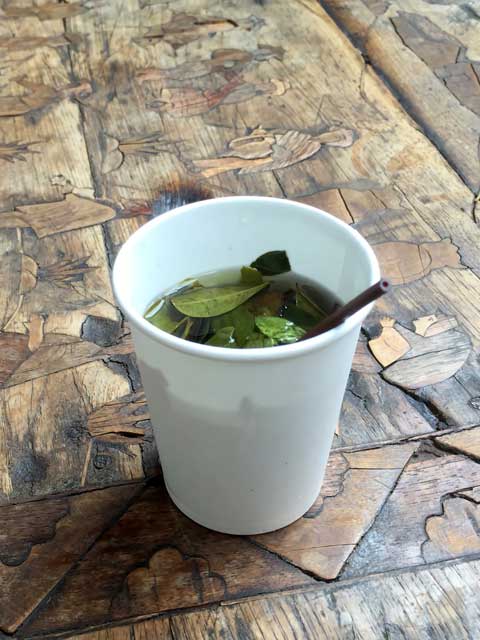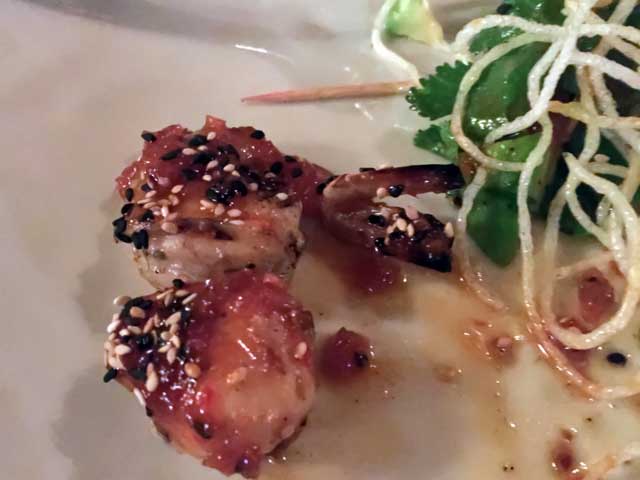
The cup of coca tea while checking in. The woodworking in the table was noteworthy.

After breakfast with Melissa and Steve, Ulises arrived and walked us to the check-in counter and up to security again. Turns out we were not on the same flight to Cusco with the Wilsons, but hope to see them tomorrow and the night after when we’ll be at the same hotels.
Landing at Cusco, we collected our bags and went outside to find our guide to the hotel and driver. Alexandra dropped a huge load of information on us during the ride to the Casa Andina Private Collection Cusco, including how to deal with the altitude (11,152 feet).
As Alexandra checked us into the hotel, we were served a cup of coca tea and I dealt with another malady when we got to our room and took a pair of Imodium caplets.
After settling in, we hooked up to the local WiFi to check mail (nothing important found).
We had lunch in the hotel restaurant where the waiter echoed Alexandra’s prescription for lunch – soup and coca tea. So we did, and will start the city tour around 1400.
Our guide, Ruben Cornejo, met us in the hotel lobby at the appointed time, along with our driver, Romulo. The drive through Cusco to the archaeological site Saqsaywaman was a major contrast with Iquitos. The buildings in Cusco were much more finished, ornamented, and regular, where Iquitos has the feel of a city thrown up haphazardly, with little thought or planning. The traffic was the same however.
Ruben led us through the site as gusty rain moved in, and it was difficult to juggle the umbrella and camera (I had left the little waterproof one in the van). I had to dap water droplets off the lens with my bandana several times.
Saqsaywaman is high above Cusco and Romulo steered the van over twisting roads dodging potholes and slowing for speed bumps (a very popular in Perú for slowing the “exuberant” traffic I guess). The next site was a satellite Inca fort to Cusco called Pukapukara. The rain had stopped earlier and the view of the countryside down to Cusco was spectacular, some of the most beautiful countryside we’ve seen.
The third and final archeological ruin (but not the last archeological site) was Q’inqu, a site with a ceremonial altar located in a natural cave.
One comment about the Inca culture and its predecessors – they were primarily farmers and do not appear to be as deeply imbued with the bloody practices in Mesoamerica exemplified by the Aztec or Maya, although human sacrifice was part of the practice. The religion was a naturalistic one worshiping the sun, moon, and stars.
Returning to Cusco to visit the cathedral and its two side chapels – one on either side – the Holy Family on the left and the Chapel to the Spanish Conquest on the right.
As one might expect, the Spanish behavior after the conquest of the Inca has many parallels to the re-conquest of Spain and the expulsion of the Moors. The population was forcibly converted to Catholicism, and the old temples were demolished and Catholic churches built on their foundations. Much of the destruction of the Inca sites was done at the bequest of the Spanish.
Much like the Moorish influence seeps through the art and architecture of southern Spain, the Inca influence could not be exterminated, and permeates the later art and architecture. Where temple walls were too sturdy to demolish, they were incorporated and masked in the European-styled construction. As mestizo artisans worked on the ornate decorations, Inca cultural iconography began to influence the presentation of various Catholic icons with the Virgin Mary taking the role of Mother Earth, and Christ assuming the Father figure.
There was no photography allowed in the cathedral so I don’t have any photos of examples of this. One quick example was the presentation of Christ on the Cross, also known as the Lord of Earthquakes, or the Black Christ. European artists frequently used women as models for the Crucifixion so the body in the sculpture or painting frequently has a feminine cast to it. Christ is always looking up heavenward in His agony. When the mestizo artisans produced the image, the body is definitely male, the loincloth is replaced with the indigenous wrap, and Christ looks downward towards the (Mother) earth.
The last site we visited was the Convent of Santo Domingo that was also an archeological site. An earthquake in the 1950 revealed just how extensive the Inca contribution to the later structure truly was.
We walked back to the hotel from convent with instructions to meet in the lobby at 0830 the next morning.
After dropping our cameras and backpack in the room we went searching for the two establishments that Alexandra had mentioned on the ride from the airport. One was a restaurant, Cicciolina. The other she described when we asked about the best place to get a Pisco Sour – Museo del Pisco.
Fortunately for us the Museo del Pisco was two blocks away from the hotel and Cicciolina was only one block beyond on the same street. So up the street we walked – slowly – and found the Pisco Museum on the corner. Jonathan had thought it might actually be a real museum of sorts, but it’s really a tapas bar with a gi-normous selection of Piscos, and an equally impressive selection of Pisco cocktails. So I ended up having a “Capitán” (Pisco, vermouth rosso (sweet), and bitters), or, as I described it, the equivalent of a “Pisco Manhattan” right down to the Maraschino cherry. At the bartenders suggestion, Jonathan had a “Pisco Carajo” (coffee infused Pisco, coffee liqueur, Bailey’s, cream, double espresso, simple syrup) – sounds like a White Russian. I made a video of the preparation of both drinks.
Those two drinks almost put us out of commission as we wobbled up the street to find Cicciolina on the second floor. We ended up with bar seating, which was fine by us as we were thinking of dining off the appetizer or tapas menu. We were considering ordering the “causa” – [“a typical Peruvian dish with our touch. A fine layer of yellow potato mash with chilis and herbs, topped with deboned ‘Guinea Pig Confit’, and a touch of caramelized apple”] – when the couple at the next table (introduced themselves as Jay and Lou) recommended it. The dish had the advantage of using shredded cui instead of the whole critter, unlike one of the paintings in the cathedral that Ruben entitled “The Last Supper with Guinea Pig.” Two other appetizers and a dessert were ordered, and it was all very, very good.
As we chatted with Jay and Lou, we found out that, although currently based in greater Boston, were very familiar with Pasadena and our favorite restaurant there – Green Street Restaurant – as Jay taught periodically at CalTech.
After the meal, we dropped into a crafts shop next door that had some spectacular woven wall hangings (they ran ~S/.2100 or $700). Despite the temptation, we returned to the hotel empty handed, but full bellied.

Evidence: BBq'd calamari, prawns & scallops; sweet & spicy chili sauce; minty, avocado and crisp noodle salad.
